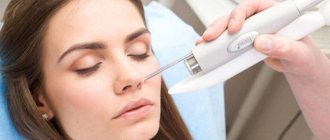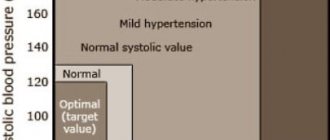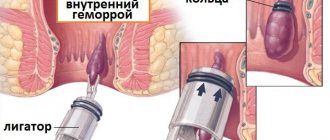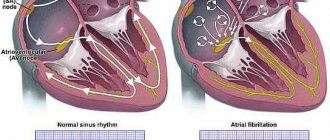Why might my nose bleed?
Nosebleeds are classified into “anterior” and “posterior.” In the first case, the cause is damage to small blood vessels, this type is usually easy to stop. The second case is considered more dangerous; bleeding occurs due to injury to large vessels located deeper in the nose, so it cannot be dealt with at home. If the blood is “spouting”, this is a reason to urgently call an ambulance.
Causes of nosebleeds include:
- nasal injuries;
- thinning of the mucous membrane;
- inflammatory processes in the nasal cavity;
- fragility of blood vessels, heart and blood diseases;
- a sharp increase in blood pressure;
- uncontrolled use of certain medications (anticoagulants, NSAIDs, vasoconstrictor drops for the common cold).
Causes of drug-induced rhinitis
Infectious or allergic rhinitis is manifested by inflammatory reactions, one of the symptoms of which is swelling of the nose. The body tries to cope with this process, and blood circulation increases in the nasal passages. As a result, an increase in the size of blood vessels contributes to the development of nasal congestion. Nasal breathing becomes difficult, the sense of smell is lost, the person rushes to get rid of these unpleasant symptoms with the help of decongestants (vasoconstrictor drops - vasoconstrictors).
From vasoconstrictor drops, blood vessels narrow, swelling quickly subsides, breathing through the nose is restored, and the sense of smell is normalized. The therapeutic effect of decongestants lasts 4-12 hours, after this period the lumen of the blood vessels increases again, swelling and congestion of the nasal passages returns. The patient knows how to get rid of the unpleasant condition and again uses vasoconstrictor drops.
If nasal vasoconstrictor drops are used correctly, addiction does not occur. The recommended period of use of the drugs is 3-7 days. Dependence manifests itself if the patient neglects the instructions for use and violates the frequency and duration of therapy. This is due to the fact that tachyphylaxis develops when the body’s response to repeated use of medications decreases. A person uses the same nasal remedies, but the vessels react poorly to them. To achieve a therapeutic effect, decongestants must be instilled more often.
The main active components of the drugs are substances such as nasazoline, oxymetazoline, xylometazoline, phenylephrine. Violation of the frequency and duration of therapy leads to the fact that the own regulation of capillary tone suffers. Up to the complete destruction of reflex regulation. The capillaries get used to narrowing from nasal drops and wait for the arrival of active components from the outside.
The longer a person uses vasoconstrictor drops, the stronger the addiction and the less chance of restoring their own regulation. You can only get rid of addiction to nasal drops with the help of an ENT specialist.
What to do if your nose bleeds?
When bleeding begins, it is important to try not to be nervous, as nervousness causes our heart to beat faster, which leads to more blood loss.
The algorithm for stopping bleeding is as follows:
- Sit up straight, tilt your head forward.
- You should be comfortable: loosen your belt and collar, open the window if necessary.
- Apply a cold, wet towel or ice to your nose and place a warm heating pad on your feet. This will help narrow the blood vessels in your nose and widen them in your legs, which will reduce bleeding.
- Pinch the bleeding vessel: squeeze the wings of the nose with your fingers for 3-5 minutes, the bleeding should stop. Also for this purpose, you can insert a gauze swab pre-moistened in hydrogen peroxide into the nostril.
If you have completed all of the above points and the blood continues to flow, call an ambulance immediately, because even a small loss of blood can lead to fainting.
What should you remember when you have a nosebleed?
- Do not lie down or let your legs be higher than your head - this will increase bleeding;
- Do not throw your head back: a large amount of blood entering the stomach can cause vomiting, in addition, blood can flow into the windpipe and make breathing difficult.
- Once the bleeding has stopped, avoid eating or drinking caffeinated drinks to avoid increased blood pressure and further bleeding.
Preventing nosebleeds
Remember, frequent nosebleeds are a reason to consult a doctor. The specialist will identify the cause of the problem and prescribe treatment, which may include the use of hemostatic agents, as well as medications that improve blood circulation.
To prevent rebleeding, a specialist may recommend:
- Taking medications and vitamins to strengthen blood vessels.
- Proper diet. Adding foods rich in vitamin K and C to the menu. Vitamin K is responsible for blood clotting; parsley, spinach, basil, bananas, avocados, broccoli, bran, etc. are rich in it. Vitamin C strengthens the walls of blood vessels, it is found in large quantities in rose hips, sweet peppers, currants, citrus fruits, etc.
- Activity and moderate physical activity: light exercise in the morning, daily walks in the fresh air, visiting the pool, etc.
Be healthy!
"Capricious" nose
Why do some people cope with a runny nose quickly and easily, while for others it drags on and becomes complicated by troubles? What solutions to the situation does modern medicine offer?
The story is told by the candidate of medical sciences, head of the otolaryngological department of the Lapino Clinical Hospital of the Mother and Child Group of Companies in the capital, Andrey Kuzmich Boklin.
Reason one
ANOMALIES OF THE NASAL CAVITY
As a rule, we are talking about a deviated nasal septum. This condition can be suspected by frequent nasal congestion and difficulty breathing. At the same time, a runny nose arising from colds and acute respiratory viral infections lasts a long time and is complicated by various types of sinus inflammation.
Treatment
The problem is solved surgically. ˇNowadays, minimally traumatic intervention can be performed. It is called septoplasty. The operation is performed without incisions on the facial skin. Through a puncture in the nasal cavity. And the final success is determined by the postoperative period. To speed up nasal healing, advanced clinics today use “breathable” tampons and silicone stents. This relieves patients from discomfort. And it allows you to reduce their hospital stay to a day.
Reason two
LOW VASCULAR TONE IN THE NOSE
In medical language, this condition is called vasomotor rhinitis. And it develops more often in young people with vegetative-vascular dystonia and low blood pressure. It also occurs with some endocrine problems. The essence of this type of runny nose is that a person’s so-called “nasal cycle” changes. Normally, the nasal turbinates skillfully regulate the volume of inhaled air, changing in size due to filling with blood. In this way they react to air temperature and humidity. In this case, the vascular tone in one of the nasal conchas is greater than in the other. And it changes approximately every hour.
But with “weak” vessels, this cycle is lengthened or shortened. “Unreasonable” congestion occurs. Problems with breathing and smell when the weather changes or pressure changes. Even stress can lead to exacerbation of vasomotor rhinitis.
Treatment
It is important to improve the functioning of the vegetative-vascular system as a whole. And from this point of view, hardening, massage of the cervical-collar area, and physical therapy are useful. Special drops and sprays are required to strengthen the walls of blood vessels and relieve swelling. As well as inhalations and physiotherapy. In particular, phonophoresis with drugs, UHF and laser.
If conservative treatment is not successful, endoscopic ENT surgery comes to the rescue. The purpose of the operation is to destroy excess choroid plexuses in the nose and prevent them from expanding due to filling with blood.
Technically, such manipulation is carried out in different ways - using ultrasound, radio waves or laser. They all have their pros and cons. But today radio wave exposure is considered the most effective.
Reason three
ALLERGY
In this case, nasal discharge usually remains clear. And in addition to them, a person is bothered by an itchy nose and sneezing attacks.
It is also common for the eyes to become red and watery. There is a sore throat and a dry cough. Unfortunately, against the background of prolonged allergies, irreversible changes can occur in the nose. Its mucous membrane grows, forming polyps. And they, in turn, begin to interfere with proper breathing and contribute to chronic inflammation of the paranasal sinuses. In this situation, it is impossible to do without an accurate diagnosis. Therefore, not only an x-ray or ultrasound is performed, but also a computed tomography scan of the sinuses. And then, to clarify the subtleties, an endoscopic examination of the nasal cavity and nasopharynx. In addition, a culture of nasal discharge and blood tests are done. This allows you to identify or exclude a bacterial infection.
Treatment
The basis of the fight against allergic rhinitis is antihistamines - tablets, sprays and drops. Seawater-based sprays should be used 2-4 times a day. They help cleanse the nasal cavity of allergens and germs. Vasoconstrictor drops relieve the symptom of congestion. But they should not be used for more than 5–7 days. In difficult cases, hormonal drugs in the form of sprays are also used. They effectively relieve swelling and allergic inflammation in the nose. But they should be used only as prescribed by a doctor and for at least a month.
Drug treatment goes well with physical therapy. As a rule, this is phonophoresis or electrophoresis with antihistamines. These procedures cleanse the nasal cavity and the respiratory tract in general. The so-called salt mines and inhalations are very effective.
However, you need to keep in mind: you can completely recover from allergic rhinitis only by getting rid of the allergen. Or, if this is not possible, undergo a special “vaccination” from an allergist. Then sensitivity to this substance or product will decrease to a minimum.
Reason four
DEPENDENCE ON MEDICINES
In this case, the cause of problems is long-term use of the medicine.
The most common culprits of medicinal rhinitis are vasoconstrictor drops and sprays, designed, on the contrary, to ease breathing during a runny nose.
In addition to the addictive effect, these seemingly harmless drugs can increase heart rate and worsen the condition of people with hypertension and glaucoma.
In addition, few people know that high blood pressure pills and some psychotropic drugs can cause a drug runny nose.
Treatment
The only way out of this situation is to cancel the causative drug, or replace it with an alternative, but safe one. However, in the first days about: swelling, difficulty breathing, difficulty distinguishing odors. Sprays can help here
based on sea water and inhalation. As well as general strengthening self-help measures - gymnastics, hardening, breathing according to Strelnikova.
And in a completely extreme case - if the nose still does not breathe - this is a small surgical correction. In meaning and technically, it resembles that of vasomotor rhinitis.
Reason Five
THINNING OF THE NASAL MUCOSA
Doctors call this problem atrophic rhinitis. It may be associated with heredity or due to poor ecology. Working in hot, dry, dusty rooms is especially unfavorable in this regard. But in addition, this type of runny nose may indicate a deficiency of vitamins or iron in the body.
A specific sign of such a runny nose is the appearance of dry crusts in the nose and periodic nosebleeds.
Treatment
The first step is to identify the factors causing the disease and eliminate them. Then local treatment is prescribed. It includes drugs that soften crusts in the nose. These are sprays based on sea water and vegetable oils. They need to be used for a long time. Ointments containing vitamins, microelements and healing substances are also useful for a “dry” nose. They improve nutrition of the mucous membrane, due to which the structure and function of the organ is restored.
Another component of the treatment regimen is agents that reduce the viscosity of nasal discharge. These are drugs with fluimucil, alkaline inhalations or simply irrigating the nose with alkaline solutions.
Vitamins and biostimulants also play an important role. They mobilize the body's regenerative properties and promote healing of nasal tissue.
Reason six
POLYPS IN THE NOSE
These formations are nothing more than overgrown areas of the mucous membrane of the nasal cavity or sinuses. For the time being, they can behave quietly, without showing themselves in any way. But as they grow and if infections occur, they provoke the development of a special type of runny nose - polypous rhinosinusitis.
Computed tomography and endoscopic examination of the nasal cavity help clarify the diagnosis, as well as measure polyps with millimeter accuracy.
Treatment
There are both conservative and surgical treatments for this problem. However, an integrated approach is most effective.
First, the doctor removes the polyps themselves. The operation is performed through the nose, without incisions and does not leave any marks on the face.
And then outpatient treatment is carried out. Its purpose is to cleanse the nasal cavity and restore damaged tissues using
special sprays. Slow down the growth of new polyps in the nasal cavity.
For this purpose, metered dose inhalers are used, which need to be used to irrigate the nasal cavity every day for at least three
months. These are hormonal in nature. But there is no need to be afraid of their long-term use. They act directly on the mucous membrane of the nasal cavity and sinuses and are not absorbed into the blood.
You can download the article in .pdf format here
How does the problem manifest itself?
Swelling of the mucous membrane during a runny nose can be recognized by the following symptoms:
- Difficulty in nasal breathing;
- Itching sensation in the nose;
- Burning sensation.
A person may also experience headaches, fever, and watery eyes. More specific symptoms depend on the cause of the swelling.
Swelling of the nasal passages can be seen by looking into the nose in the light or shining a flashlight. The mucous membrane will look swollen and reddened. Most often, it is difficult to examine the membrane due to discharge, so it is recommended to do this after cleansing the nose with salt water.
Treatment of addiction to nasal drops
The first stage is awareness of the problem. It is necessary to accept that an addiction to nasal drops or sprays has formed. Addiction worsens the quality of life and threatens serious complications.
The next step is to seek help from a competent ENT doctor. A specialist will help distinguish medicinal rhinitis from seasonal or allergic rhinitis, decide how serious the complications are, and select adequate treatment to restore nasal breathing. The sooner the patient contacts the doctor, the more successfully vascular function will be restored.
Drug addiction sometimes takes years to form, so you can’t get rid of it in a couple of days. Nasal breathing improves gradually. Medicines, physiotherapy methods and surgical interventions are used. To make you feel better, the doctor prescribes intranasal anti-inflammatory drugs containing synthetic glucocorticosteroids. The drugs improve the condition of the mucous membrane, facilitate the discharge of mucus, and relieve the symptoms of inflammation. The therapy is complemented by physiotherapeutic procedures - laser treatment, medicinal extracts (herbal medicine), the use of ultraviolet irradiation, tube quartz treatment, etc.
Surgical methods of treatment:
- Laser bloodless operation (vaporization), in which altered mucous membranes are removed by evaporation.
- Radio wave thermal reduction.
- An ultrasonic waveguide makes it possible to reduce the volume of blood vessels, after which healthy capillaries are formed in their place and nasal breathing is restored.
- Submucosal vasotomy, conchotomy.
Long-term use of vasoconstrictor drugs leads to serious consequences. Addiction will not go away on its own; specialist help is needed. You can get the necessary treatment at the CELT clinic. Here are high-quality diagnostics and effective therapy. Make an appointment with an ENT doctor right now.
Our services
The administration of CELT JSC regularly updates the price list posted on the clinic’s website. However, in order to avoid possible misunderstandings, we ask you to clarify the cost of services by phone: +7
| Service name | Price in rubles |
| Appointment with a surgical doctor (primary, for complex programs) | 3 000 |
| Endoscopic rhinoscopy | 1 500 |
| X-ray of the paranasal sinuses | 2 200 |
All services
Make an appointment through the application or by calling +7 +7 We work every day:
- Monday—Friday: 8.00—20.00
- Saturday: 8.00–18.00
- Sunday is a day off
The nearest metro and MCC stations to the clinic:
- Highway of Enthusiasts or Perovo
- Partisan
- Enthusiast Highway
Driving directions
Causes of swelling of the nasal mucosa
Swelling of the nasal mucosa during a runny nose can be caused by the following reasons:
- Infection
. Infectious rhinitis is often caused by viruses and is part of the manifestations of ARVI. In the absence of proper treatment or the presence of predisposing factors, bacteria join the viruses, and the inflammation becomes purulent. - Violation of vascular tone in the mucous membrane
. Because of this, their inadequate expansion or contraction occurs1. The problem most often provokes is the abuse of vasoconstrictor drugs. - Allergic reaction
. This refers to allergic rhinitis, which occurs during the flowering period of plants. Less often it is provoked by: dust, animal hair. - Traumatic injury
. Swelling occurs almost immediately after injury, and the timing of its disappearance varies from person to person4. - Adenoids
. Enlargement of the nasopharyngeal tonsil contributes to swelling and congestion in childhood1.
General principles for troubleshooting
- Rinse the nose with hypertonic saline solutions at room temperature;
- Use of vasoconstrictor drops;
- Avoiding hypothermia and drafts;
- Normalization of diet;
- Removing accumulations of mucus from the nasal cavities (especially important if we are talking about infants who begin to refuse mother's milk).
It is not recommended to use heating, as are any untested herbal, alcohol and other folk remedies.
How to recognize the cause of nasal swelling and the type of runny nose?
Treatment of a runny nose, accompanied by swelling of the mucous membrane, should influence the cause of the disease. Nasal congestion accompanies many diseases, but in order to choose the right methods and drugs for treatment, you need to be able to distinguish between them.
Swelling of the nose without a runny nose is usually the result of injury or any defects in the cartilaginous and bone structures of the nose 3. The problem bothers the person constantly and is not particularly amenable to any treatment methods.
Pronounced purulent discharge in large quantities often indicates a bacterial infection. Additionally, the following symptoms may appear:
- Temperature increase;
- Cough;
- A sore throat;
- Body aches;
- Marked weakness.
If the discharge is serous, that is, transparent and liquid, resembling water, then we can talk about a viral infection. A distinctive feature will be the sudden appearance of symptoms and their connection with hypothermia and contact with other patients.
An allergic reaction is characterized by the appearance of swelling and runny nose at a certain time. Rhinitis is caused by direct contact with the allergen. A runny nose will bother you during the flowering period of the plant, when you are near certain flowers, bushes or trees. A reaction to animal fur appears upon contact with them (can affect all animals or specific species). Specific signs of an allergic nature of a runny nose: lacrimation, frequent sneezing, itching and burning sensation in the nose, the appearance of clear discharge.
Symptoms of bleeding
The main symptom is the appearance of blood from the nasal sinuses, its flow outward and inward (through the nasopharynx). Bleeding may also be accompanied by the following symptoms:
- increased heart rate;
- decrease in blood pressure;
- nausea;
- general weakness;
- headache;
- dizziness;
- feeling of fullness in the ears;
- paleness of the skin of the face and hands.
Bleeding can be either light or heavy. Depending on the volume of blood lost, there are 3 degrees of severity:
- light – up to 500 ml;
- average – 500-1400 ml;
- heavy – more than 1400 ml.








